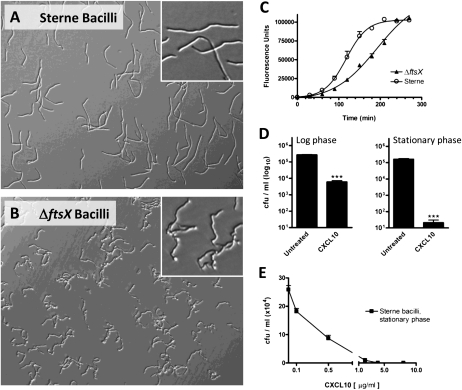Fig. 3.
Influence of bacterial growth phase on CXCL10 susceptibility. (A and B) ΔftsX bacilli exhibit a distinct morphology; Sterne and ΔftsX bacilli were visualized by light microscopy in the absence of chemokine treatment. Representative fields from five independent experiments are shown at 200× magnification; Insets show expanded views of bacilli. (C) ΔftsX bacilli grow more slowly than Sterne bacilli; bacterial growth rates were determined in tissue culture medium and analyzed by using Alamar blue analysis. Data are expressed as relative fluorescence units and represent mean values ± SEM; n = 3 independent experiments, curve comparison P < 0.001. (D) Nongrowing bacilli are highly susceptible to CXCL10; log phase and stationary phase Sterne strain bacilli were treated with 8 μg/mL CXCL10 for 30 min before viability was assessed by cfu determination. Data are expressed as cfu/mL (log10 scale) and represent mean values ± SEM; n = 3 independent experiments, ***P < 0.001 compared with untreated controls. (E) CXCL10 susceptibility among nongrowing Sterne bacilli; stationary phase bacilli were treated with CXCL10 for 30 min before cfu determination. Viability is expressed as cfu/mL (x104) and represents mean values ± SEM; n = 3 independent experiments.

